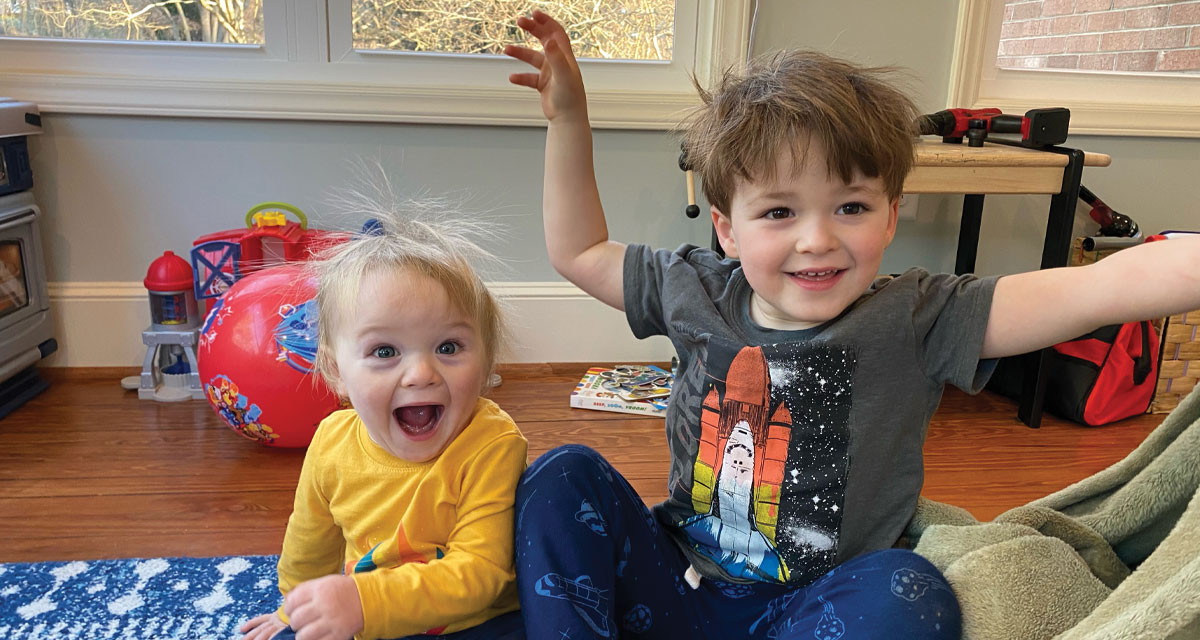Our second son, Luke, was born with the same weight, in the same hospital room and to the same parents as his big brother, and we expected the same typical development. We dreamed of our boys running around in our back yard, riding bikes down the path behind our neighborhood, and generally making merry mischief together. And for the first several months of his life, we still had that expectation. For nearly six months, Luke developed mostly “normally,” but by seven months, it was becoming clear that something was not quite right. He was not bearing any weight or pushing against any resistance with his legs and generally seemed weak. We had him evaluated by a pediatric physical therapist (PT) and then our pediatrician. By the time we saw our doctor, Luke’s decline had started to progress quickly, and he had stopped moving his legs at all. Our pediatrician listened to my recounting, did an exam, and referred us to neurology, where we were seen just two days later.
After an agonizing week of waiting for test results, we received our diagnosis: spinal muscular atrophy (SMA), a rare, genetic neuromuscular disorder that causes low muscle tone and muscle weakness. Four types of SMA exist on a continuum. In type 1, symptoms are typically present from birth or very early on and weakness progresses quickly, ultimately affecting breathing, and most individuals historically have not survived past the age of two. Type 2 typically presents after six months, and while many affected can sit with assistance, they cannot stand or walk. Luke was somewhere between Type 1 and Type 2.
Fortunately for Luke, a new gene therapy, Zolgensma, had been approved for children two and under in May of 2019, just four months before Luke was born. As agonizing as waiting for the test results to confirm SMA was, waiting for the test results to know if he was a candidate for this therapy was even worse. Zolgensma is the world’s most expensive single-dose medication, costing 2.1 million dollars. Worth every penny, this medication corrects Luke’s missing gene copy, thus stopping the progression of SMA. A week and a half after the diagnosis, exactly three weeks to the day from seeing our pediatrician, Luke did, in fact, receive Zolgensma. During those three weeks, he had lost the ability to sit up on his own, his swallowing had became affected, his joints had started popping, and his legs had become totally still. Three weeks was pretty exemplary in today’s medical landscape, but it was three long weeks.
Luke received Zolgensma through a tiny vein in his foot on June 3, 2020, my 35th birthday, but the greater gift came two days later, when I saw Luke’s legs move while he was on the changing table. His movement was coming back. In the subsequent months, we saw steady, slow improvement, as our life consisted of dozens of doctors’ appointments and blood draws and lots and lots of PT. Our home became filled with standers and gait trainers and a host of PT tools. To gain the benefits of water therapy, Luke began taking twice-weekly swim lessons at Salem Gymnastics, and he often swims as well at the Jerry Long YMCA. Luke is at home in the water, where movement is much easier.
Despite all these therapies and improvements, we were still hopeful for more. For Christmas last year, Bodhi, Luke’s three-year-old brother, asked Santa for a PJ masks toy and for Luke to crawl. A couple of weeks later, in late December of 2020, Luke was fortunate to begin a second therapy, Evrysdi, a daily oral medication which had just been approved in August of 2020. About one month after starting Evrysdi, we saw significant gains. Luke was starting to bear some weight in his legs; he could play for long periods on all fours or kneeling. His eating was improving. His stamina was increasing. Santa was a bit delayed, but in March, Luke began to crawl. He now crawls all around our house.
For now, we don’t know exactly what Luke’s future holds. Balancing hope and realism is an incredible challenge in raising a kid with a chronic medical condition or disability. But no matter what his physical abilities, whether one day we find him running around our back yard or biking down our path, he and his brother have already found ways to make merry mischief and bring joy to every day.
***We would like to share a special thank you to Dr. Elizabeth Mark of Propel Physical Therapy, Dr. Soren Johnson, and all the folks of Novant Health Robinhood Pediatrics and Dr. Michael Cartwright of Wake Forest Baptist Health for their excellent care. For more information about SMA, newborn screening or other stories about SMA, I encourage people to visit Cure SMA.


















